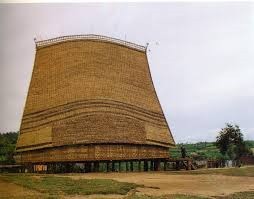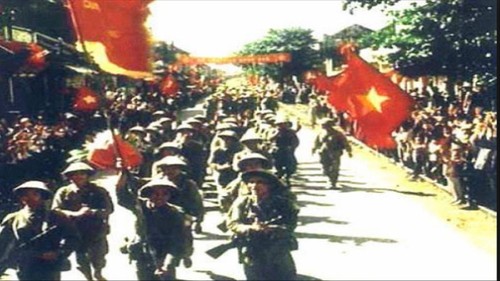A: First on our show today, let’s check out the recent weather in Vietnam because many of VOV’s listeners are interested to know more.
B: Partly due to climate change, the weather in Vietnam has been unusual lately. In the north, we are in mid-autumn and the weather is supposed to be dry, cool with some breeze. The weather is usually very comfortable with sunny but cool days. But recently, due to low pressure in the central region, it has been rainy for days in the north and the temperature is between 23 to 29 degrees Celsius.
 Torrential rain causes serious traffic congestion in various streets in Hanoi Torrential rain causes serious traffic congestion in various streets in Hanoi
|
A: In the central region, it’s cloudy and there are occasional showers and thunderstorms. It’s warmer than in the north with the temperatures ranging from 23 to 33 degrees. It’s now monsoon season in the south. There are a mix of sun and scattered showers throughout the day. The temperatures vary between 25 and 33 degrees Celsius.
A: Next, we’d like to welcome Mr. Chris Smolinski to VOV. We received your first feedback on September 27 with a reception report for the program the previous day on the frequency of 9840 khz from 1230 to 1257 UTC.
B: In his email, he wrote: “I used a net SDR receiver and a 670 foot sky loop antenna. I have been an SWL since 1978, although I have just again started listening to shortwave broadcast stations very recently. I look forward to listening to your station again.”
A: Thank you, Mr. Smolinski for tuning in to VOV. We’ll send you a QSL card to confirm your report, and our frequency list and program schedule. Our program is also available on the internet at vovworld.vn and on our mobile phone apps. We look forward to hearing more from you.
B: This week, Christer Brunstrom of Sweden reported on a VOV program on September 27 at 1600 UTC on the frequency of 9730 khz with an excellent SINPO of 45444 on the west coast of Sweden. He wrote: “I certainly enjoyed today’s broadcast and it is interesting to note that Vietnam is taking climate change seriously. Some don’t. I would appreciate the QSL card showing the waterfall you discussed. Also I would like to know more about Xo Dang ethnic group.
 Rong house of the Xo Dang Rong house of the Xo Dang
|
A: The Xo Dang, who speak a Mon-Khmer language called Xo Dang, are one of the largest ethnic groups in the Central Highlands – consisting of about 170,000 people. They live mainly in Kon Tum province and scattered in the mountain areas of Quang Ngai and Quang Nam province.
B: The Xo Dang grow rice and other crops, raise cattle and poultry, collect wild vegetable and fruits, and catch fish. They weave fabric and forge farm tools. Their life and production are largely dependent on nature, so they worship many genies and supernatural forces.
A: Xo Dang men wear loin-cloths and go shirtless. Women wear blouses, skirts, and shoulder scarves. Black is the dominant color of their clothing. Women prefer silver earrings and necklaces and stone-beads around their hips and ankles.
B: The Xo Dang’s costumes are similar to other ethnic groups in the Central Highlands. But they embroider more flowery images on their costumes. At rituals and festivals, men wrap a scarf over their shoulders like warriors. Women wear sleeveless tops and long dresses. When they dance, the men look powerful and the women are graceful.
A: Multiple generations of Xo Dang live together in a long stilt house. They don’t have family names. A prefix of A or U on a name identifies an individual as male. A prefix of Y indicates a female.
B: The Xo Dang have rich folk art that includes dances, songs, and music. At festivals and New Year celebrations, they play gongs and sing epics about their roots and the history of the Central Highlands. They make many types of musical instruments from bamboo such as the T’rung xylophone, the Klong-put, and various flutes.
A: Xo Dang festivals are closely associated with agricultural production- for example, the new rice celebration and the crop blessing ritual. Some ceremonies, which used to be performed within the family, have become community events. The village patriarch hosts the ceremonies and represents the villagers in thanking the genies for providing them with bumper crops.
B: The Xo Dang in each locality have unique cultural features. Their festivals take place at the beginning of the year after harvest. In January every family prepares a pig offering to celebrate the new rice crop and pray for abundance. The patriarch is a prestigious and respected older man. He chairs community events and represents the villagers in all affairs. Every village has a Rong house which hosts meetings and displays village assets such as gongs and statues of ancestors.
 Traditional musical instruments of the Xo Dang Traditional musical instruments of the Xo Dang
|
A: We have many other stories about the Xo Dang group and other ethnic groups of Vietnam in our weekly segment “Colorful Vietnam-Vietnam’s 54 ethnic groups”. Be sure to check it out.
B: In a letter to VOV this week, Gary Edward Embry, a retired radio studio engineer of the US, sent us reception reports for the broadcasts on June 17, August 15th, and September 12th on the frequency of 7315 khz. In his letter, he shared his love for Vietnamese music, especially songs about Hanoi. In today’s show, we’d like to dedicate the song “Marching to Hanoi”, a signature song marking Hanoi’s liberation day 63 years ago on October 10.
 Vietnamese soldiers marched to liberate Hanoi Vietnamese soldiers marched to liberate Hanoi
|
A: That was a song featuring the triumphant atmosphere of Hanoi’s Liberation Day 63 years ago. The victory on October 10, 1954 put an end to French colonial rule and opened a new era of development for Hanoi and Vietnam.
B: After Liberation Day, Hanoi began to develop the economy, build socialism and support the southern region in opposing US imperialists, contributing to the victory of the 1975 spring offensive, which liberated southern Vietnam and reunified the country.
A: After 1975 Hanoi joined the nation’s reform efforts and has become the national center of politics, culture and economics.
B: We’d like to acknowledge letters and emails from Richard Nowak of the US, Ram Babu Kumar of India, Eddy Prabowo of Indonesia, Norizumi Taguchi of Japan, and Peter Ng of Malaysia. We greatly appreciate your feedback and comments on the technical aspects of our programming. We’ll confirm your reports with QSL cards soon.
A: We welcome your feedback at: English section, Overseas Service, Radio the Voice of Vietnam, 45 Ba Trieu Street, Hanoi, Vietnam. Or you can email us at: englishsection@vov.org.vn. You’re invited to visit us online at www.vovworld.vn, where you can hear both live and recorded programs. Check out our VOV Media App available on both IOS and Android platforms to hear our live broadcasts. We look forward to your feedback on the mobile version of vovworld.vn. Once again, thank you. Good bye until next time.